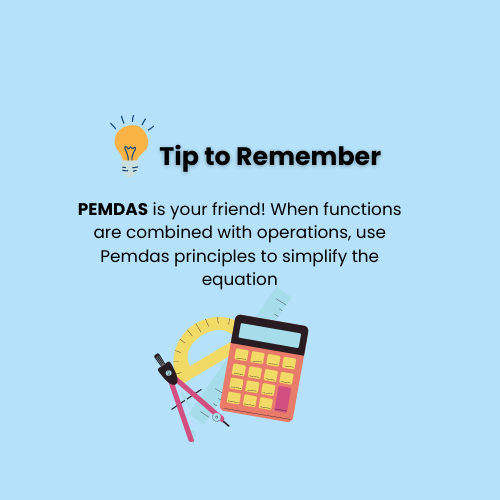How to Solve Equations
Learning how to evaluate basic functions is necessary to build a good foundation before you approach more advanced topics such as graphing functions and finding inverses. If you’re ready to learn how to solve equations so you can be well-prepared to move on to more advanced subjects, you’re in the right place!
There are a few variations of function problems., and today, I’ll demonstrate how to solve several common problems.
Ways to Solve Equations
PROBLEM 1
f(-5) = (-5)^2 + 3(-5) + 5 First plug the input (-5) into the expression for x.
f(-5) = 25 - 15 + 5 = 15 Then you solve and simplify the expression.
Answer: f(-5)
This is a very basic function evaluation problem.
We are given a rule ( x^2 + 3x + 5 ) and must evaluate this function when x = -5.
Remember that unlike an algebraic equation you may be used to, instead of evaluating for the identity of a variable, we know the identity and must plug it into an expression.
PROBLEM 2
f(4) = √4 + (12 - 4) Plug in the input (4) into equation for x
f(4) = 2 + 8 = 10 Simplify the expression
Answer: f(4)=10
This is another relatively simple function problem. However, this time we are finding the square root of x.
PROBLEM 3
g (0) = 0^2 + 7 First evaluate g(0) by plugging 0 into the rule.
g (0) = 7 Simplify the expression.
f (g(0)) = f(7) Since g (0) is equal to 7, we can rewrite the initial equation.
f (g(0)) = 2(7) + 1 Then compute f (7) by plugging 7 into the equation for x.
Answer: f(g(0)) = 15
This problem is different from anything we have seen because it a composition of functions, meaning that functions are combined to result in one whole function.
For example, functions g and f are combined into f(g(x)). When solving a problem like this you must start from the inside and go outwards, similar to PEMDAS where we start with the most inward parenthesis first.
For the first part of the problem, we can ignore the f and simply solve g(0). Once we get the value we can rewrite the equation as f (7) because g (0) = 7.
From there we solve for f(7) and get 15.
PROBLEM 4
f(2) = (2)^2 + 3(2) + 1 First solve f(2) and simplify the equation
f(2) = 4 + 6 + 1 = 11
g(3) = 3(3) + 5 Next solve g(3) and simplify the equation
g(3) = 9 + 5 = 14
f(2) + g(3) = 11 + 14 Add f(2) and g(3) to receive one number
Answer: f(2) + g(3) = 25
This problem is similar to #1, the only difference is that there are two functions to solve for. An easy way to think about these types of functions is to use PEMDAS. Think of each function as its own equation in parentheses. Once you simplify each function you can add them together like you would for a PEMDAS problem.
PROBLEM 5
f(2x) = 10 - 2(2x) Rewrite the f function replacing the x value with the input(2x).
f(2x) = 10 - 4x Simplify the equation.
g(2x) = 3(2x) - 6 Replace and simplifying the g function
g(2x) = 6x - 6
Since f(2x) = g(2x)
10 - 4x = 6x - 6 Solve the algebraic equation to find the x value.
16 = 10x
Answer: x = 8/5 or 1.6
This is a challenging problem. However it follows the same principles as the other problems. We first must evaluate the functions given that the input is 2x for both functions.
Once we solve the functions, we can set them equal to one another because it is given that f(2x) = g(2x). Once you set the terms equal to one another, all you have to do is solve the equation to find x.
Key Takeaways to Help You Solve Equations
Solving equations gets easier with practice. Here are the key takeaways that will help you become a pro at solving equations:
Evaluating functions is the basis for more advanced math. Make sure you have a good foundation and understanding before learning to graph functions.
When given a function and an input, replace the x value in the function with the input to evaluate the function at that input.
When writing the answer be sure to include the input, for example rather than writing that the answer is 15, write that f(2) = 15. This is because the work is more clear similar to why we box our answers to make them stand out.
When given several functions inside one another, like #3 from the examples, start from the inside out.
PEMDAS is your friend! When functions are combined with operations, use PEMDAS principles to simplify the expression
Solving Equations: Practice Problems
Problem 1 +
Given f(x) = x^2 - 4x + 7 determine f(6)
f(6):
f(6) = (6)^2 - 4(6) + 7
f(6) = 36 - 24 + 7 = 19
Answer: f(6) = 19
Problem 2 +
Given f(x) = x/4 + 3 determine f(16)
f(16):
f(16): 16/4 + 3
f(16) = 4 + 3 = 7
Answer: f(16) = 7
Problem 3 +
Given f(x) = x(x - 3) + 5, g(x) = x^3 determine f(4) - g(2)
f(4):
g(2):
f(4) = 4(4 - 3) + 5
g(2) = 2^3 = 8
f(4) = 4(1) + 5
g(2) = 8
f(4) = 9
f(4) - g(2) = 9 - 8Answer: f(4) - g(2) = 1
Problem 4 +
Given f(x) = x^2 and g(x) = 3x - 3 determine g(2 + f(3))
Hint: Remember to use PEMDAS
f(3):
g(11):
f(3) = 32
g(11) = 3(11) - 3
g(2 + f(3)) = g(11)
g(11) = 33 - 3 = 30
Answer: g(2 + f(3)) = 30
Problem 5 +
Given f(x) = 2(5 + 7x) and g(x) = x + 6, Solve the following equation for x: f(2x) = g(3x)
Hint: first plug the inputs into each function, then solve the algebraic equation.
f(2x) = 2(5 + 7(2x))
f(2x) = 10 + 28x
g(3x) = 3x + 6
Since f(2x) = g(3x) 10 + 28x = 3x + 6 25x = -4 x = - 4/25
Answer: x = -.16 or - 4/25
Final Thoughts
For more math lessons, check out our math series on algebra, expressions, radians, and our two part post on quadratic equations.
Prefer to work with a tutor? Sign up to get free, on-demand math tutoring in as soon as five minutes!







